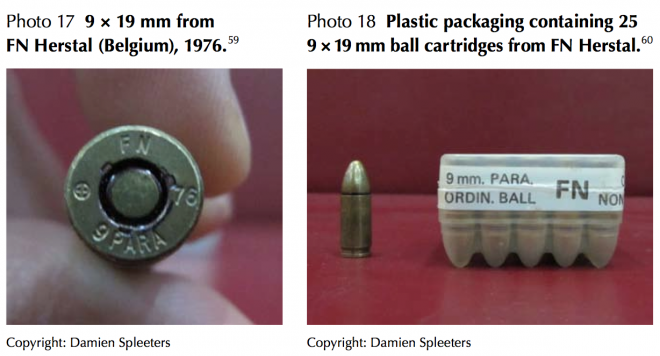The Headstamp Trail, A Report On The Ammunition Used During The Libyan Revolution

TFB friend Nic Jenzen-Jones was commissioned by the Small Arms Survey to document the ammunition used in the Libyan Revolution. The report can be downloaded here. Nic discovered that ammunition was procured form the usual suspects (China, Russia, Pakistan etc.) but I was surprised to discover that a lot of FN Herstal made rounds in Gadaffi’s arsenal. FN discovered that by throwing in a few FN303 less lethal launchers in among a lot of ammunition, they could get approval to export a lot of ammunition on humanitarian grounds. A risky move in my opinion. If Britain or the USA had committed ground troops to the civil war it would have been a public relations disaster for the company, not to mention putting their lucrative US military contracts in jeopardy.
VIDEO
The identified cartridges were manufactured predominantly in factories located in Belgium, China, and former Eastern Bloc countries.Among the cartridges assessed for this study, the headstamps suggest regular procurement of ammunition over the past 40 years. However, only two of the identified headstamps indicate a production date from the 1992– 2003 period of the UN Security Council’s arms embargo on Libya.Cartridges in Eastern Bloc calibres are the most common and widely available; this finding is supported by photographic evidence and their relatively low prices on the local black markets. NATO-calibre rounds are typically scarcer and often associated with those small arms that are considered more prestigious. These factors have resulted in NATO-calibre ammunition being sold at artificially inflated prices.Handgun ammunition is uniformly more expensive and less available than ammunition for long guns. Handgun ammunition is highly sought after because buyers have begun opting for concealable firearms over the commonly available Kalashnikov variants and Fabrique Nationale d’Herstal (FN Herstal) Fusil Automatique Léger (FAL) rifles of the conflict period.

What is also interesting is the presence of unmarked ammunition. Nic suspects this unmarked ammunition comes from North Korea, who we know exports arms and ammunition despite UN embargoes.
The diverse mix of ammunition in Libya reminds me the book Charlie Wilson’s War. I read the book a very long time ago but, if my memory serves me correctly, the CIA agent who worked closely with Charlie Wilson claimed that the agency went on a buying rampage, purchasing ammunition from organizations all over the world in an attempt to hide their involvement (or at least maintain plausible deniability). The agent claimed that the CIA even contracted the Chinese government to manufacture ammunition for them, although China has always denied this.
If western countries did in fact covertly supply ammunition to the rebels, you can be sure they would only supply ammunition which did not have a paper trail that lead back to them.
